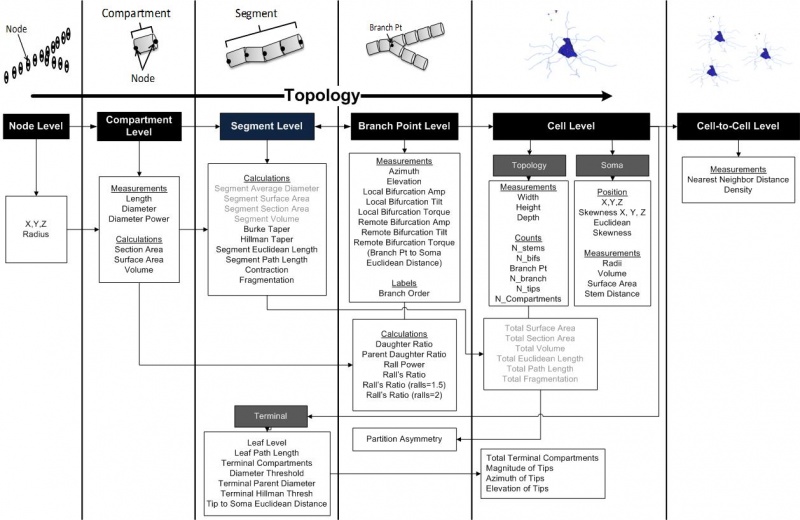|
|
| Line 37: |
Line 37: |
| | | | | | |
| | |- | | |- |
| − | | Soma Position | + | | Soma Position (*) |
| | | | | | |
| | | [[File:Somasurface.png|150px]] | | | [[File:Somasurface.png|150px]] |
| | | XYZ coordinate of the soma centroid. | | | XYZ coordinate of the soma centroid. |
| | |- | | |- |
| − | | Soma Radii | + | | Soma Radii (*) |
| | | | | | |
| | | [[File:Somasurface.png|150px]] | | | [[File:Somasurface.png|150px]] |
| | | Average radius of the soma. | | | Average radius of the soma. |
| | |- | | |- |
| − | | Soma Surface Area | + | | Soma Surface Area (*) |
| | | Number of surface voxels of the soma | | | Number of surface voxels of the soma |
| | | [[File:Somasurface.png|150px]] | | | [[File:Somasurface.png|150px]] |
| | | Surface area of the soma. | | | Surface area of the soma. |
| | |- | | |- |
| − | | Soma Volume | + | | Soma Volume (*) |
| | | Number of voxels of the soma | | | Number of voxels of the soma |
| | | [[File:Somasurface.png|150px]] | | | [[File:Somasurface.png|150px]] |
| Line 306: |
Line 306: |
| | | | | | |
| | |- | | |- |
| − | | Tip to Soma Euclidean Distance | + | | Tip to Soma Euclidean Distance (*) |
| | | ''D'' | | | ''D'' |
| | | [[File:TipToSoma.png|150px]] | | | [[File:TipToSoma.png|150px]] |
| | | Straight line distance from the soma point to the terminal tip. | | | Straight line distance from the soma point to the terminal tip. |
| | |- | | |- |
| − | | Branch Pt to Soma Euclidean Distance | + | | Branch Pt to Soma Euclidean Distance (*) |
| | | ''D'' | | | ''D'' |
| | | [[File:TipToSoma.png|150px]] | | | [[File:TipToSoma.png|150px]] |
L Measures is a research tool for making quantitative morphological measurements from neuronal reconstructions. There are 43 measurements including area measurements of soma, length measurements of processes, angular twists and turns of processes, calculation of the number of terminals and bifurcations, and many more.
| Features
|
Formula or Equation
|
Image
|
Description
|
| Dimensions
|
|
|
| Width X
|
w
|
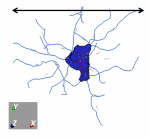
|
Measured along the x-axis of a neuron.
|
| Height Y
|
h
|

|
Measured along the y-axis of a neuron.
|
| Depth Z
|
d
|
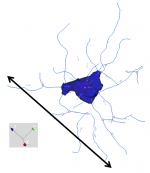
|
Measured along the z-axis of a neuron.
|
| Soma Features
|
|
|
| Soma Position (*)
|
|
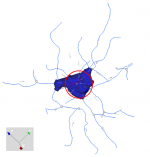
|
XYZ coordinate of the soma centroid.
|
| Soma Radii (*)
|
|

|
Average radius of the soma.
|
| Soma Surface Area (*)
|
Number of surface voxels of the soma
|

|
Surface area of the soma.
|
| Soma Volume (*)
|
Number of voxels of the soma
|

|
Volume of the soma.
|
| Skewness X, Y, Z (*)
|
|
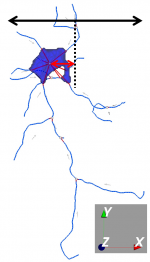 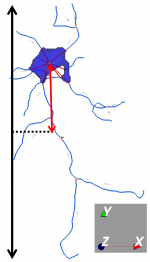 
|
Center of the soma deviation from the center of the cell (see Dimensions).
|
| Euclidean Skewness (*)
|
Failed to parse (Cannot write to or create math temp directory): \sqrt{(x_1-x_2)^2+(y_1-y_2)^2+(z_1-z_2)^2}
|
|
Distance from the center of the soma to the center of the cell.
|
| Counts
|
|
|
| Stems
|
n
|
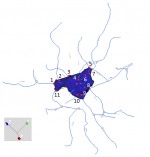
|
Number of stems attached to the soma.
|
| Branch Pt
|
n
|
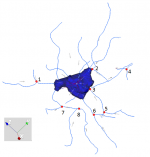
|
Number of bifurcations of a neuron.
|
| Segments (or Branch)
|
n
|
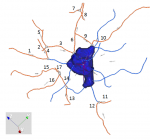
|
Number of branches of a neuron. (A branch is between two critical points or between a critical point and the tip.)
|
| Tips
|
n
|

|
Number of terminal tips of a neuron.
|
| Compartment features
|
|
|
| Type
|
t = 1, 2, 3, or 4
|
|
Compartments are assigned four different types: 1=soma, 2=axon, 3=dendrites, and 4=apical dendrites (are dendrites that emerge from the apex of a pyramidal cell).
|
| Diameter
|
D
|

|
Diameter of each compartment of the neuron.
|
| Diameter Power
|
D1.5
|
|
Diameter of each compartment of the neuron raised to the power of 1.5.
|
| Length
|
l
|

|
Measured length of each compartment.
|
| Surface Area
|

(area of cylinder w/o top and bottom)
|

|
Surface area of each compartment.
|
| Section Area
|

|

|
Cross-sectional area of each compartment.
|
| Volume
|

|

|
Volume of the compartments.
|
| Burke Taper
|

|

|
The change in diameter over pathlength between two critical points (the current and previous one).
|
| Hillman Taper
|

|

|
The ratio of the change in diameter to the initial diameter of two critical points. The initial diameter is usually larger.
|
| Branch (Segment) features
|
|
|
| Branch Order
|
n = 0,1,2,3...
|

|
Order of branch with respect to the soma starting at 0 for branches attached to soma.
|
| Euclidean Distance
|

Straight line distance
|

|
Straight line distance between the two endpoints of a branch.
|
| Path Length
|
A + B + C + D + E + ...
|

|
Summation of the individual compartment lengths that form a branch.
|
| Contraction
|

|

|
Ratio between the Euclidean distance of a branch and its path length.
|
| Fragmentation
|
n
|

|
Total number of compartments that form a branch between two bifurcation points, or between a bifurcation point and a terminal tip.
|
| Helix
|

|
|
Helicity of the branches of the neuronal tree. Needs to be at least 3 compartments long to compute the helicity.
|
| Fractal_Dim
|
 or or

(ei is EucDistance and pi is PathDistance)
|
|
Fractal dimension metric of the branches in the dendrite trees.
|
| Bifurcation features
|
|
|
| Daughter Ratio
|
Da / Db
Da = larger daughter diameter
Db = smaller daughter diameter
|

|
Ratio between the diameter of the bigger daughter and the smaller daughter of the current bifurcation. The diameters are measured at the initial part of the branches right when they exit the bifurcation.
|
| Parent Daughter Ratio
|
Da / Dp,Db / Dp
|

|
Ratio between the diameter of a daughter and its father for each critical point. The diameters are measured immediately before and after the bifurcation point.
|
| Partition Asymmetry
|

|
|
Compares the symmetry of the processes in terms of the number of tips on the left daughter to the number of tips on the right daughter of a bifurcation.
|
| Rall Power
|

|

|
Best value that fits the equation with extreme 0-5, resolution 1/1000 over the range.
|
| Pk (Rall's Ratio)
|

|

|
n = [0, 5]
|
| Pk_classic (Rall's Ratio)
|

|

|
Rall power is set to 1.5
|
| Pk_2 (Rall's Ratio)
|

|

|
Rall power is set to 2
|
|
|
|
|
| Azimuth (*)
|
ϴ (in degrees)
|
|
Azimuth of the daughter segment at a bifurcation point on the x-y plane.
|
| Elevation (*)
|
ϴ
|
|
Elevation of the daughter segment at a bifurcation point extending into the z plane from the azimuth.
|
| Bif_ampl_local
|
ϴ
|

|
The local angle formed right at the vertex of the branches; initial angle formed as the two daughter branches exit the bifurcation.
|
| Bif_ampl_remote
|
ϴ
|

|
From the bifurcation, it is the angle to the tips of the two daughter branches. Angle between two branches; angle between the ends of two growing segments (in degrees) at the current bifurcation; angle between the two daughter bifurcations and/or terminal ends (whichever comes first) at the current bifurcation. (Daughter bifurcation means the next bifurcation encountered after the current bifurcation.)
|
| Bif_tilt_local
|
ϴ
|

|
The smaller of the two angles between the end of the parent branch and the initial part of the daughter branches at the bifurcation; angle between the last compartment of the parent branch and the first compartment of each daughter branch at the bifurcation.
- There are two daughter branches for each bifurcation, which gives two angles.
|
| Bif_tilt_remote
|
ϴ
|

|
The smaller of the two angles between the first daughter compartment of the current bifurcating father and the previous father compartment of the previous father bifurcation; angle between the last part of the previous branch and the initial part of the next branches (skipping the branch in-between).
|
| Bif_torque_local
|
ϴ
|
|
Angle between the current plane of bifurcation and the previous plane of bifurcation; the planes are defined by the initial part of the daughter branches as they exit the point of bifurcation.
|
| Bif_torque_remote
|
ϴ
|
|
Angle between the current plane of bifurcation and the previous plane of bifurcation; the plane of bifurcation is defined by a bifurcation and its two daughter bifurcations or terminal ends (whichever comes first).
|
| Terminal bifurcation features
|
|
|
| Terminal degree
|
n
|

|
Total number of tips each compartment will terminate into.
|
| Terminal Compartments
|
0 (if not terminal), 1 (if terminal)
|

|
Assigns "1" for all the compartments in the terminal branch.
|
| Terminal Parent Diameter
|
D
|

|
Diameter of last bifurcation before the terminal tips.
|
| Diameter Threshold
|
D
|

|
Diameter of first compartment after the terminal bifurcation leading to a terminal tip; initial diameter of the branch exiting the terminal bifurcation.
|
| Hillman Threshold
|
0.5P + 0.25D1 + 0.25D2
P: parent diameter,
D1 = 1st daughter diameter,
D2 = 2nd daughter diameter
|

|
Computes the weighted average diameter between 50% of father and 25% of daughter diameters of the terminal bifurcation.
|
| Other features
|
|
|
| Tip to Soma Euclidean Distance (*)
|
D
|

|
Straight line distance from the soma point to the terminal tip.
|
| Branch Pt to Soma Euclidean Distance (*)
|
D
|

|
Straight line distance from the soma point to the branch point.
|
Note: Branches are modeled as a series of compartments. Critical points refer to bifurcation points and terminal tips.































 or
or

















